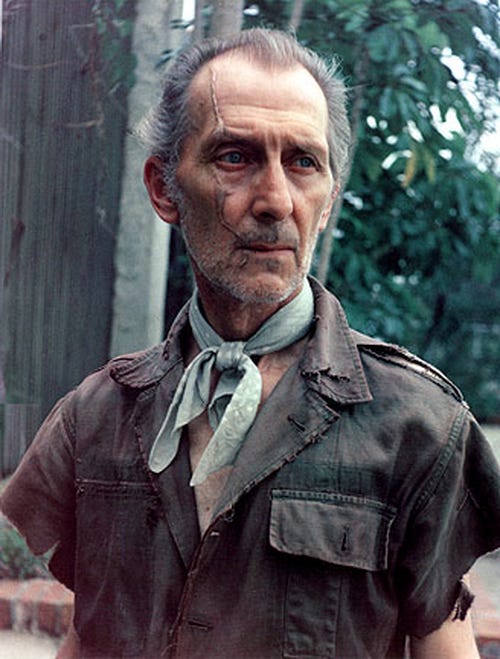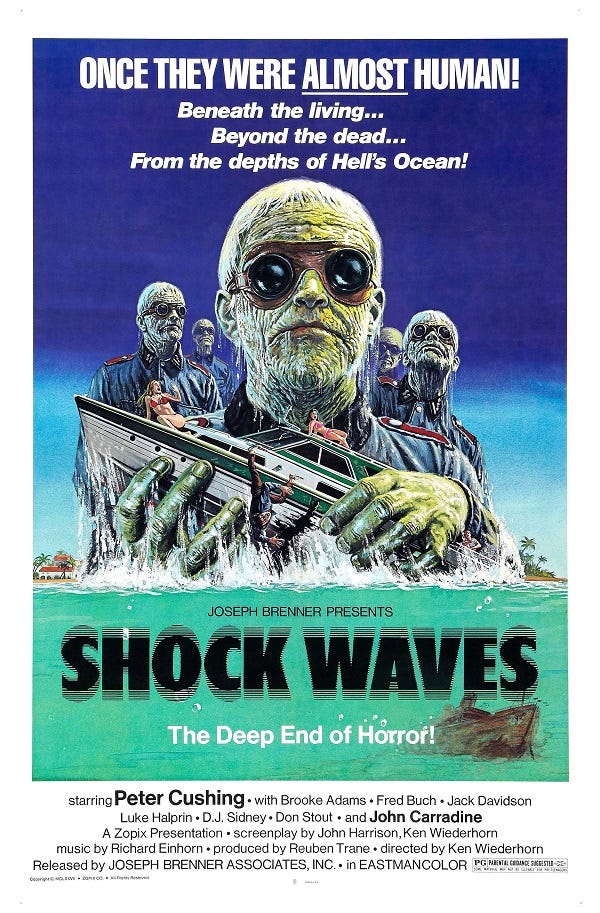It’s October So I Watched a Horror Movie I’d Never Seen Before: ‘Shock Waves’
What's worse than Nazis or zombies? Nazi zombies. But what's worse than Nazi zombies? Wet Nazi zombies.
I’ve seen a lot of horror movies, but not as many as I’d like. so I’m going to spend the rest of this month filling in some gaps.
If a single image could make a movie, Shock Waves would be a classic. Long after I’ve forgotten everything else about the film, I’ll remember the first moment a pale, platinum blonde, undead SS officer wearing shaded goggles emerges from the ocean. Silent and expressionless, he moves as if the decades spent under the water were just a brief time out and that it was now time to resume the business of spreading fascism and killing everyone who might stand in the way. Accompanied by an eerie synth score by Richard Einhorn, a composer who’s divided his time between the worlds of classical music and low-budget filmmaking, it’s an arresting moment that takes up a few unforgettable seconds of screen time. If the 86 minutes that surround it aren’t quite as memorable, it’s still more than many films manage.
Which isn’t to say Shock Waves is a bad movie, even if it’s tough to make a case for it as a wholly successful one. Its origins, as described by director and co-writer Ken Wiederhorn in a 2013 interview, were humble and its aims modest. Reuben Trane, the film’s producer and cinematographer, had secured financing for a horror movie. The two agreed that both water and Nazis were scary and decided to include both. And with that they were off. Any statement about the persistence of fascism after the fall of the Third Reich was an afterthought, yet it’s hard to think of a better visual shorthand for it than a zombie Nazi, so white as to look like a parody of the aryan ideal, gleaming in the sun.
At the very least, Wiederhorn seems to have understood the power of the image, which appears throughout the film. It’s striking, if a little less effective each time. That’s partly due to diminishing returns and partly to Shock Waves revealing itself as a film with some pretty tough-to-ignore technical and artistic limitations. Shot on 16mm for little money, the film sometimes uses its griminess to its advantage and other times includes images so grainy they challenge the definition of “usable.” That no more than six—and often far fewer—Nazi zombies appear on screen at any given moment doesn’t help. Sure, even one Nazi zombie would be concerning, but the inability of the film’s central characters to fend off a handful of corpses as they’re picked off one-by-one reflects badly on their desire to survive.
Shock Waves plays out in flashback, sandwiched by the voiceover of narration of Rose (Brooke Adams*), the sole survivor of the action about to unfold. Rescued from a rowboat adrift in what’s seemingly the Caribbean — the film, shot in Florida, never makes this clear and the Mediterranean would make more sense — she then recalls how she got there. A passenger on a small pleasure trip on a boat captained by the cranky, aged Captain Morris (John Carradine), Rose first senses trouble when a strange light appears in the sky during the day, a sense deepened when a nighttime accident forces them to abandon the sinking ship for the uncertain shores of a nearby island the next day. Captain Morris doesn’t survive the trip, but most of his crew and passengers do.
That doesn’t last. Exploring the island, they find an abandoned hotel in a state of decay with a single resident: a scarred, never-named SS Commander (Peter Cushing). Though creepy, he’s also the only person who can explain what’s going on and how they might make their way back to civilization. Unfortunately, his answers aren’t very comforting. What’s going on is their collision has accidentally awakened the soldiers he used to command, the todeskorps (or “death corps”), undead SS officers designed to survive where the living can’t. (Specifically, they’re dealing with todeskorps intended to man submarines that would never need to surface.) As for escaping, they might be able to make it to another island, but probably not now that the todeskorps have been revived and are out for blood.
Once its premise has been established and its big-name horror stars dispatched after a couple of scenes, Shock Waves follows the expected playbook. The survivors argue about how and where best to fend off the zombie threat — a tip of the cap to Night of the Living Dead — before discovering no place is truly safe and becoming zombie fodder. It’s familiar but largely effective, helped by the production value of shooting at two abandoned luxury hotels that had fallen into disrepair. **
Still, it’s really only the Nazi angle that sets Shock Waves apart, but that’s no small thing. Shock Waves was neither the first film to feature Nazi zombies nor the last. (One of the earliest, 1943’s Revenge of the Zombies, also starred Carradine. More recent examples include Dead Snow and its sequel Dead Snow 2: Red vs. Dead.) But Shock Waves belongs as much to its particular era as to any microgenre. Arriving in the same small flood of films about Nazis surviving, maybe even thriving, in contemporary times—see also Marathon Man, The Boys from Brazil, and The Odessa File—it makes literal the idea that the past won’t stay buried.
It’s also of a piece with some dubious (and still persistent) attempts to understand Hitler and the Third Reich via the occult. Wiederhorn has said he was inspired by the 1960 book Morning of the Magicians, one of the earliest and most influential of those attempts. Later entries included books like The Spear of Destiny and The Occult Reich (all of which could undoubtedly have been found on David Bowie’s nightstand during the stretch of the ‘70s in which he lived on cocaine and milk and got deep into this way of thinking). Which isn’t to say that Nazism did not have some roots in occult beliefs or believers within its ranks. (I haven’t read Nicholas Goodrick-Clarke’s The Occult Roots of Nazism: Secret Aryan Cults and Their Influence on Nazi Ideology, but it has a good reputation.) But it is to say that the notion of a Third Reich secretly obsessed with (maybe successfully) harnessing supernatural forces is the stuff of fantasy and Hellboy comics.
On the one hand, it’s easy to see attempts to link fascism to satanic forces as infantile, an attempt to shirk the need for a deeper consideration of historic evil by waving it away as the work of the devil. Looked at another way, however, it seems like an acknowledgment of how deep that evil goes, that the actions of Hitler and his followers can only be equated with Satan and the deepest wells of evil available to the human imagination.
The zombie movie works as a sponge that can soak up virtually any dark metaphor. (I know I’m in the minority in liking it, but Jim Jarmusch’s The Dead Don’t Die, with its soul-deep sense of exhaustion, looks more and more like the quintessential zombie movie of the current era.) Which brings us back to that single striking image of the zombie emerging from the depths. It’s one that could just as easily have been tailored for our times as the 1970s or any other moment when it maybe felt safe to say the world had moved beyond the horrors of World War II and the inhuman ideology that fueled it. Beware of what’s below the surface waiting for the nudge that will set it free.***
* Shock Waves is among Adams’ earliest credited film appearances. Her next would be Days of Heaven.
** The Biltmore Hotel in Coral Gables and the Biltmore in West Palm Beach. Both have since been restored.
*** Bits of trivia that did not fit in the piece.
Wiederhorn went on to have an interesting career. He directed both Meatballs II and Return of the Living Dead II as well as the well-regarded slasher film Eyes of a Stranger and other films. In the interview linked to above, he discusses how he knew his days as a producer for CBS News were numbered when Dan Rather asked him about Shock Waves, which he took on as a summer assignment. CBS did not find this amusing.
The cast also includes Flipper star Luke Halpin.
One of the zombies was played by Jay Maeder, a Miami Herald reporter who took the job as a larkish undercover assignment without anyone on the film finding out. He seems to have had fun.








When I saw this I was young enough to be mislead by the poster into thinking that there would a gargantuan Nazi zombie in it who would lift a boat up with his hand. It was a formative disappointment.
further Dead Don't Die fan clocking in, for all that it's presented with Jarmusch's usual sense of humour and playfulness I remember finding its resigned weariness much more disturbing than the more overt shock tactics of that summer's more attention-grabbing horror release, Midsommar; haven't revisited since that first viewing, can't imagine the last five years have done much to diminish it though.